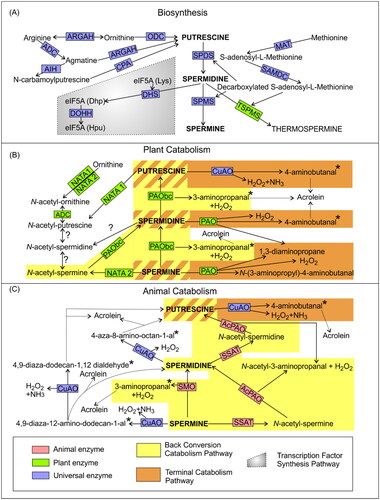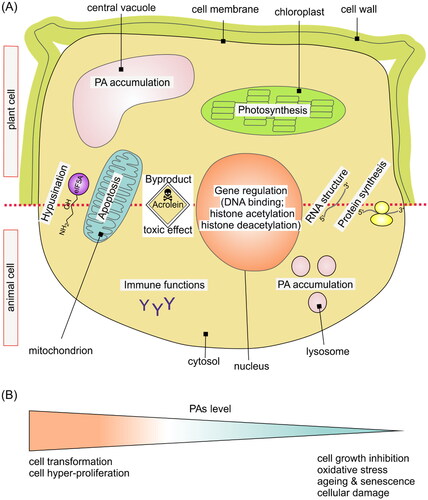Figures & data
Figure 1. Polyamine metabolic pathways in plants and animals. (A) Biosynthetic pathways are common between plants and animals, except for one reaction that leads exclusively to the formation of thermospermine in plants. (B) Animal catabolism pathways. (C) Plant catabolism pathways. Enzymes specific for plants are marked in green, enzymes exclusive for animals are marked in red, universal enzymes are marked in blue. Dotted arrow lines indicate spontaneous aldehyde decomposition into the toxic compound known as acrolein. Grey box indicates transcription factor synthesis pathway. Yellow boxes indicate conversion catabolism pathways. Orange boxes indicate terminal catabolism pathways. The question mark (?) indicates poorly understood pathways. Asterisk denotes unstable aldehydes that can spontaneously decompose into acrolein. AcPAO: acetylpolyamine oxidase; ADC: arginine decarboxylase; AIH: agmatine iminohydrolase; ARGAH: arginase/agmatinase; CPA: N-carbamoylputrescine aminohydrolase; CuAO: copper-containing amine oxidases; DHS: deoxyhypusine synthase; DOHH: deoxyhypusine hydroxylase; MAT: S-adenosyl-L-methionine synthetase; NATA: N-acetyltransferase activity; ODC: ornithine decarboxylase; PAO: polyamine oxidase; PAObc: polyamine back conversion oxidase; SAMDC: S-adenosyl-L-methionine decarboxylase; SPDS: spermidine synthase; SMO: spermine oxidase; SPMS: spermine synthase; SSAT spermidine/spermine N1-acetyltransferase; TSPMS: thermospermine synthase.

Table 1. Plant and animal terminal catabolism and back conversion catabolism pathways. AcPAO: acetylpolyamine oxidase; CuAO: copper-containing amine oxidase; NATA: N-acetyltransferase activity; PAO: polyamine oxidase; PAObc: polyamine back conversion oxidase; Put: putrescine; SMO: spermine oxidase; Spd: spermidine; Spm: spermine; SSAT spermidine/spermine N1-acetyltransferase.
Figure 2. Polyamines and cell biology. (A) The upper part of the figure shows a schematic plant cell, and the lower part shows an animal cell. Polyamines regulate gene expression at the transcriptional level (DNA binding, histone deacetylation/acetylation) and at the translational level by affecting RNA structure and protein synthesis. Acrolein, which is a by-product of PA catabolism, is a toxic molecule that can cause inhibition of photosynthesis and increase in early stages of cell death, suggesting that it takes part in initiation of PCD. Acrolein targets proteins, specifically mitochondrial proteins, causing apoptosis-like cell death. Another by-product of PA catabolism is hypusine – a compound essential for eIF5A activity, and absolutely vital for survival of the cell. Polyamines in the plant cell accumulate in the vacuole, and in the animal cell in lysosomes. In the plant cell, inhibition of PA catabolic enzyme activities drastically slows down the senescence-associated chlorophyll loss. In the animal cell, polyamines also have anti-aging effects and immune functions. (B) Imbalance in the homeostasis of PA levels in the cell can lead to many disorders at both the cellular and organismal level. Increased biosynthesis of PAs and overaccumulation of PAs lead to cell transformation and hyper-proliferation. On the other hand, increased PA catabolism and consequently low levels of polyamines increase oxidative stress, which leads to senescence, aging, and cellular damage.

